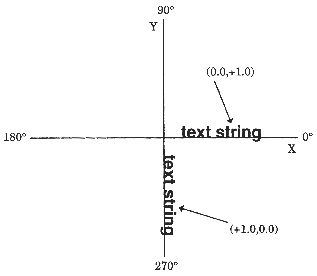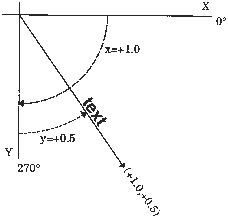TEXUP
Specifies the orientation (angle) of the text string
| Operating state: | GKOP, SGOP, WSAC, WSOP |
| Default: | upx=0, upy=1 |
Syntax
return-code-variable=GSET('TEXUP',upx, upy);
Return Codes
- This function returns:
-
0, 8, or 74. See Return Codes for DSGI Routines and Functions.
Details
The GSET('TEXUP',
. . . ) function sets the angle of the text string. DSGI uses the
values of character up vectors to determine the angle of a text string.
The character up vector has two components, upx and upy, that describe the
angle at which the text string is placed. The angle is calculated
with the following formula:
angle=atan(upx/upy)
Effectively, when DSGI
is calculating the angle for the text, it uses upx and upy as forces that are pushing the string toward an angle. The natural
angle of text in the upx direction
is toward the 6 o'clock position. In the upy direction, text naturally angles at the 3 o'clock position. If upx is greater than upy, the text is angled toward 6 o'clock. If upy is greater than upx, the
text is angled toward 3 o'clock. Natural Angle of Text shows the angle of text when the values for upx and upy are (0.0, 1.0) and (1.0, 0.0).
As you change the values
of upx and upy, the coordinate that has the highest value
is taken as the angle, and the lowest value as the offset. Varying the Angle of Text shows the angle of text when the character up vector values
(+1.0, +0.5) are used.
You can use the following
macro to convert angles measured in degrees to character up vectors:
%macro angle(x);
if mod(&x, 180)=90 then do;
if mod(&x,270) = 0 then
xup = 1.0;
else
xup = -1.0;
rc = gset("texup", xup, 0.0);
end;
else do;
b = mod(&x, 360);
/* adjust y vector for 2nd and 3rd quadrants */
if b > 90 and b lt 270 then
yup = -1.0;
else
yup = 1.0;
a=&x*1.7453292519943300e-002;
xup = tan(-a);
/* adjust x vector for 3rd quadrant */
if b > 180 and b le 270 then
xup = -xup;
rc = gset("texup", xup, yup);
end;
%mend angle;
data _null_;
rc = ginit();
rc = graph("clear", "angle");
rc = gset("texalign", "left", "base");
rc = gset("texheight", 5);
rc = gset("texfont", "swissl");
%angle(180);
rc = gdraw("text", 50, 50, "180");
%angle(80);
rc = gdraw("text", 50, 50, "80");
%angle(600);
rc = gdraw("text", 50, 50, "600");
rc = graph("update");
rc = gterm();
run;
